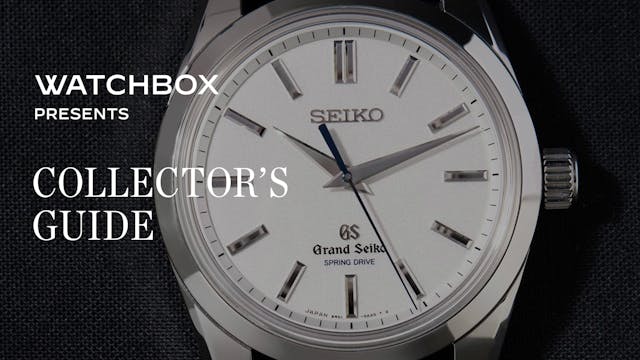Tim Mosso Reviews Rolex Milgauss Z-Blue With History, Prices, and Buyer's Guide
Collector's Guide
•
8m 26s
Contact Team Mosso for pricing and availability.
Email: [email protected]
Phone: (484) 560-6284
The Rolex Milgauss is the original Rolex engineer’s watch. Launched in 1956, the original Milgauss – so named for its resistance to 1,000 gauss of magnetic flux density – evolved through three generations to become today’s Oyster Perpetual Milgauss 116400. Watch collectors and watch buyers regard this luxury watch as a perfect blend of technical capability and high style. With an electric blue dial, green crystal, and orange accents, the Milgauss Z-Blue is the most dramatic member of an historically frumpy family. More than that, the Z-Blue is the most colorful watch in the modern Rolex watch catalog.
Cold War arms races and the promise of civilian nuclear energy fueled the rise of “big science” in the 1950s. Western governments partnered with research universities and private industry to advance the burgeoning field of sub-atomic physics. The laboratories of CERN, or Conseil Européen pour la Recherche Nucléaire, became the leading international centers for research in the field. Powerful eletromagnetics played increasingly large roles in this field of science, and this was anathema to the mechanical watches that dominated timekeeping during the mid-20th century. Rolex, IWC, Jaeger-LeCoultre, Omega, and even Patek Philippe responded by creating a new category of watch: the “engineer’s watch.”
Initially, Rolex Milgauss references 6543 and 6541 offered protection against the effects of magnetic flux densities of 1,000 gauss. A soft iron inner cage for the movement was the watchmaker’s key to achieving this resilience. Milgauss reference 1019 arrived in 1960 and ran until 1988 when the Milgauss collection was discontinued in its entirety.
2007 marked the resurrection of the Rolex Milgauss and a reimagining of the once staid technician’s watch. Now 40mm in stainless steel, the Milgauss 116400 was an uncompromising luxury watch and precision instrument all at once. The previous 80,000 ampere per meter antimagnetism surged to multiples of its original rating thanks to a new niobium-zirconium hairspring, antimagnetic escapement, and the return of the Milgauss’ long-running iron Faraday cage. A watch collector could order his antimagnetic watch with a clear crystal and a black dial, a clear crystal and a white dial, or a green-tinted crystal with a black dial; the last of these, the “glace vert” became a sensation. Indeed, the green crystal Milgauss was the most sought Rolex watch of the year.
In 2014, Rolex discontinued the clear crystal Milgauss to focus on the GV models, and it took that concept to the extreme with the “Z-Blue.” Essentially a Milgauss GV with an electric blue dial, the Z-Blue instantly propelled the Milgauss to an unaccustomed level of fashion, glamor, and daring. At launch, the Milgauss Z-Blue became a fashion Rorschach test; various pundits called the new Rolex “postmodern,” “garish,” “brilliant,” and “offbeat.” The press and Rolex collector community didn’t know what to make of the silliest dial ever to grace an engineer’s watch; some went so far as to dub the Milgauss Z-Blue as the “Rolex for Rolex haters” because it flew in the face of so many brand conventions.
Initially, the Milgauss Z-Blue sold slowly. Rolex dealers frequently sat on Z-Blue inventory for weeks or months even as other stainless steel Rolex sports watches commanded waiting lists. The Z-Blue was available for purchase on demand, and aftermarket prices sat below the retail list price for the Z-bluest Milgauss. That began to change in 2022. Rolex Daytona, Submariner, and GMT-Master II prices expanded so fast and so far that watch collectors began to look at secondary Rolex models like the Yacht-Master, Oyster Perpetual, Explorer II, and the Milgauss. As watch buyers awakened to the rarity and quirky appeal of the 116400 GV Z-Blue, its aftermarket strengthened accordingly. As of March 2023, the retail $9,300 Milgauss Z-Blue trades between $12,000 and $13,000 as a preowned watch.
Technically speaking, every 116400 Milgauss is internally identical. A Rolex automatic caliber 3131 provides 48 hours of power reserve, earns a COSC Swiss chronometer certification, and enjoys ten-year service intervals. The Milgauss benefits from an Oyster case that provides 100-meter water resistance. Finally, the latest Milgauss combines the original iron Faraday cage with assortment components engineered specifically to resist both static and electromagnets.
More than a lab appliance, the Milgauss Z-Blue is an article of culture, pop culture, fashion, and wristwatch counterculture. Very few Rolex brand purists list the Z-Blue atop their hierarchy of favorites, and Rolex diehards avoid the quirky Milgauss entirely. But for the enthusiast of science, history, or industrial design, the Z-Blue offers rare relief from the Rolex corporate culture of uniformity.
Up Next in Collector's Guide
-
Grand Seiko Spring Drive 8 Days Buyer...
The Grand Seiko Spring Drive 8 Day isn't designed as an answer to Rolex or Omega. It isn't simply the flagship of the Grand Seiko watch brand. The Grand Seiko SBGD001 (and SBGD201) is Japan's response to luxury watches from haute horlogerie brands including Patek Philippe, Audemars Piguet, F.P. J...
-
Patek Philippe Chronograph 5070P: Is ...
Among chronograph watches, the Patek Philippe 5070 occupies the summit of Olympus. Originally launched at Basel in 1998, this 42mm mechanical monster quickly built a reputation as the ultimate power watch for collectors with the taste and the budget required to put it on their wrists. And the Pat...
-
Rolex GMT Master II Pepsi Bezel Histo...
Contact Team Mosso for pricing and availability.
Email: [email protected]
Phone: (484) 560-6284In 1954, Rolex released the GMT Master, a special pilot's watch designed specifically with Pan-Am airline pilots in mind. For 2022, the Rolex GMT Master II 126710BLOR carries the flame for the wo...



